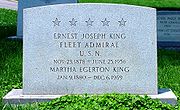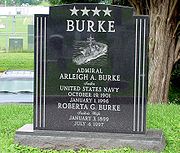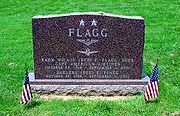
United States Naval Academy Cemetery
Encyclopedia

Cemetery
A cemetery is a place in which dead bodies and cremated remains are buried. The term "cemetery" implies that the land is specifically designated as a burying ground. Cemeteries in the Western world are where the final ceremonies of death are observed...
at the United States Naval Academy
United States Naval Academy
The United States Naval Academy is a four-year coeducational federal service academy located in Annapolis, Maryland, United States...
in Annapolis, Maryland
Annapolis, Maryland
Annapolis is the capital of the U.S. state of Maryland, as well as the county seat of Anne Arundel County. It had a population of 38,394 at the 2010 census and is situated on the Chesapeake Bay at the mouth of the Severn River, south of Baltimore and about east of Washington, D.C. Annapolis is...
.
History
In 1868 the Naval Academy purchased a sixty-seven acre piece of land called Strawberry Hill as part of their efforts to expand after the American Civil WarAmerican Civil War
The American Civil War was a civil war fought in the United States of America. In response to the election of Abraham Lincoln as President of the United States, 11 southern slave states declared their secession from the United States and formed the Confederate States of America ; the other 25...
. Within a year of its acquisition part of the property became the cemetery. Since its beginning the cemetery has become the final resting place for Medal of Honor recipients, Superintendents of the Naval Academy, midshipmen, and former employees of the Academy and hundreds more of the nation's veterans. The cemetery is also home to monuments that do not mark remains, but commemorate the heroism of individuals who gave their life in service to their country. The Jeannette Monument, erected in 1890, is the most notable such monument it was built in memory of the men who lost their lives in the Jeannette Arctic Expedition
USS Jeannette (1878)
The first USS Jeannette was originally HMS Pandora, a Philomel-class gunvessel of the Royal Navy, and was purchased in 1875 by Sir Allen Young for his arctic voyages in 1875-1876. The ship was purchased in 1878 by James Gordon Bennett, Jr., owner of the New York Herald; and renamed Jeannette...
.
Columbarium
In 1987, the Naval Academy constructed a columbariumColumbarium
A columbarium is a place for the respectful and usually public storage of cinerary urns . The term comes from the Latin columba and originally referred to compartmentalized housing for doves and pigeons .The Columbarium of Pomponius Hylas is a particularly fine ancient Roman example, rich in...
adjacent to the cemetery on College Creek. The columbarium was built by the Naval Academy Alumni Association with $500,000 in gifts from alumni and friends of the Academy. This included a major grant from the George and Carol Olmsted Foundation in memory of Jerauld L. Olmsted, Class of 1922. The columbarium offers resting places for those who wish to be inurned at the Naval Academy.
The columbarium is approximately 160 feet long and six feet high on a three-tiered pedestal. All exterior surfaces are white marble. Each niche front is removable by a special key. Niches are assigned in consecutive order and cannot be reserved in advance.
In front of the columbarium stands a memorial donated by the Class of 1937 in honor of the Academy graduates who died in the line of duty and whose bodies were never recovered.http://www.usna.edu/cemetery/columbarium.htm
Notable burials



- Captain Edward L. Beach, Jr.Edward L. Beach, Jr.Edward Latimer Beach, Jr. was a highly-decorated United States Navy submarine officer and best-selling author....
(1918–2002) - Admiral Arleigh A. Burke (1901–1996)
- William J. CroweWilliam J. CroweAdmiral William James Crowe, Jr. was a United States Navy Admiral who served as Chairman of the Joint Chiefs of Staff under Presidents Ronald Reagan and George H. W. Bush, and as the ambassador to the United Kingdom under President Bill Clinton.-Biography:Crowe was born in La Grange, Kentucky...
(1925–2007) - Commander William B. CushingWilliam B. CushingWilliam Barker Cushing was an officer in the United States Navy, best known for sinking the Confederate ironclad CSS Albemarle during a daring nighttime raid on October 27, 1864, a feat for which he received the Thanks of Congress.-Early life and career:Cushing was born in Delafield, Wisconsin,...
(1842–1874) - Theodore Gordon EllysonTheodore Gordon EllysonTheodore Gordon Ellyson, USN , nicknamed "Spuds", was the first United States Navy officer designated as an aviator . Ellyson served in the experimental development of aviation in the years before and after World War I. He also spent several years before the war as part of the Navy's new...
(1885–1928) - Rear Admiral Wilson F. FlaggWilson FlaggWilson Falor "Bud" Flagg served in the United States Navy, achieving the rank of Rear Admiral. On October 15, 1993 he was censured for failing to prevent the 1991 Tailhook conference scandal, effectively ending further advancement...
(1938–2001) - Ben Hebard FullerBen Hebard FullerBen Hebard Fuller was a Major General in the United States Marine Corps and served as Commandant of the Marine Corps between 1930 and 1934.-Biography:...
(1870–1937) - Rear Admiral Harold HauserHarold HouserHarold Alexander Houser was a United States Navy Rear admiral, and the 35th Governor of American Samoa from September 10, 1945 to April 22, 1947. Houser was born in Fort Valley, Georgia, and graduated from the Marion Military Institute before receiving an appointment to the United States Naval...
(1897–1981) - Fleet Admiral Ernest J. King (1878–1956)
- Joseph M. ReevesJoseph M. ReevesJoseph Mason "Bull" Reeves was an admiral in the United States Navy, who was an early and important supporter of U.S. Naval Aviation...
(1872–1948) - Rear Admiral Frederick Lois RiefkohlFrederick Lois RiefkohlRear Admiral Frederick Lois Riefkohl , a native of Maunabo, Puerto Rico, was an officer in the United States Navy and the first Puerto Rican to graduate from the United States Naval Academy and to be awarded the Navy Cross. The Navy Cross is the second highest medal, after the Medal of Honor, that...
(1889–1969) - Colonel John W. Ripley, USMC, (1939–2008)
- Clarence McCluskyC. Wade McCluskyRear Admiral Clarence Wade McClusky, Jr., was a United States Navy aviator during World War II. He is credited with playing a major part in the Battle of Midway...
(1902–1976) - Jesse WallaceJesse WallaceJesse Rink Wallace was a United States Navy Captain and the 29th Governor of American Samoa. He served as Governor for a period of only ten days from July 30, 1940 to August 8, 1940. Wallace was born in Beardstown, Illinois on July 7, 1899. On June 20, 1918, Wallace was appointed to the United...
(1899–1961) - Lieutenant General Pedro Augusto del VallePedro del ValleLieutenant General Pedro Augusto del Valle was a United States Marine Corps officer who became the first Hispanic to reach the rank of Lieutenant General...
, USMC, (1893–1978) - Bandmaster Charles A. ZimmermanCharles A. ZimmermanCharles A. Zimmermann was an American composer of marches and popular music. A graduate of the Peabody Conservatory of Music in Baltimore, he was appointed bandmaster at the United States Naval Academy in 1887 at the age of 26. He served as the Academy's bandmaster until his death from a brain...
(1861–1916)
Medal of Honor recipients
- Isaac Campbell Kidd
- Bruce McCandlessBruce McCandlessBruce McCandless I was an officer of United States Navy who received the Medal of Honor during World War II for his heroism on board the , during the Naval Battle of Guadalcanal, November 13, 1942. He retired with the rank of Rear Admiral...
- Frederick Vallette McNairFrederick V. McNair, Jr.Frederick Vallette McNair, Jr. was an officer of the United States Navy and a recipient of the Medal of Honor for his actions at the beginning of the U.S. occupation of Veracruz, Mexico....
- Daniel MontagueDaniel Montague (Medal of Honor recipient)Daniel Montague was a United States Navy sailor and a recipient of America's highest military decoration—the Medal of Honor—for his actions in the Spanish-American War.-Military career:...
- James Bond Stockdale
- William Peterkin UpshurWilliam P. UpshurMajor General William Peterkin Upshur was the recipient of his nation's highest military decoration—the Medal of Honor—for his actions in 1915 during the Haitian Campaign.-Biography:...
- Wainwright Richard, Jr.Richard Wainwright (World War I naval officer)Commander Richard Wainwright, Jr. was an officer in the United States Navy during World War I who received the Medal of Honor for actions during the 1914 Veracruz action.-Biography:...
- Thomas Calvin Cooney
- Robert SommersRobert Sommers (Medal of Honor)Robert Sommers was a sailor in the U.S. Navy during the American Civil War. He received the Medal of Honor for his actions during the Second Battle of Fort Fisher on January 15, 1865.-Military service:...
- Eugene B. FluckeyEugene B. FluckeyRear Admiral Eugene Bennett Fluckey , nicknamed "Lucky Fluckey", was a United States Navy submarine commander who received the Medal of Honor during World War II.-Early life and career:...
Superintendents of USNA
- Charles Turner Joy
- Draper Laurence KauffmanDraper L. KauffmanRear Admiral Draper Laurence Kauffman was a pioneering underwater demolition expert, who served during the 1960s as 44th Superintendent of the United States Naval Academy. During World War II, he organized the first U.S. Navy Demolition Teams, which later gave rise to the SEALs...
- Ronald F. MarryottRonald F. MarryottRear Admiral Ronald F. Marryott was the Superintendent of the United States Naval Academy from 1986 to 1988. He served as president and CEO of the George C...
- Charles Cochran Kirkpatrick
- Charles L. Melson
- Charles Stamps Minter
- Louis M. Nulton
- James L. Holloway, Jr.James L. Holloway, Jr.Admiral James Lemuel Holloway, Jr. was a four-star admiral in the United States Navy who served as superintendent of the United States Naval Academy from 1947–1950; as chief of naval personnel from 1953–1957; and as commander in chief of all United States naval forces in the eastern Atlantic and...
Eligibility requirements
To be buried at the United States Naval Academy Cemetery is an honor, below are the requirements to be eligible for burial, note that Naval Academy graduates must attain a flag rank while on active duty in order to be eligible.1. Those eligible for burial in the Naval Academy Cemetery are:
- Officers, midshipmen, or enlisted persons of the Navy or Marine Corps on active duty at the Naval Academy, Naval Station, Annapolis, or the staff of the Naval Medical Clinic, Annapolis.
- Those Naval Academy graduates who have served on active duty with the rank of Rear Admiral or Brigadier General, or senior thereto, and such others as the Secretary of the Navy or the Superintendent may designate.
- Unremarried spouse of an officer or enlisted person of the Navy or Marine Corps who is buried or eligible to be buried in the Naval Academy Cemetery. In the event the spouse remarries, his or her eligibility is automatically terminated.
- Any officer, former officer, or enlisted person of the Navy or Marine Corps whose spouse is buried in the Naval Academy Cemetery.
- Stillborn and infant children of the officers or enlisted persons on active duty at the Naval Academy; Naval Station, Annapolis; or Naval Medical Clinic, Annapolis may be buried in a specific lot reserved for such cases. For purposes of this regulation, an infant is considered to be a child who has not reached 7 years of age.
- Graduates of the Air Force Academy or West Point who cross commissioned to the Navy or Marine Corps and completed 20 years of commissioned service with the rank of Rear Admiral or Brigadier General, or senior thereto.
2. Those eligible to make a reservation for future burial in section 17 of the Naval Academy Cemetery are Naval Academy graduates who have served on active duty with the rank of Rear Admiral or Brigadier General or senior thereto and such others as the Secretary of the Navy or Superintendent may designate. Individual lots in section 17 are not reserved in advance. They are assigned sequentially at the time of need.
3. Nothing in these regulations will change or alter cemetery reservations and commitments made under previous regulations.

